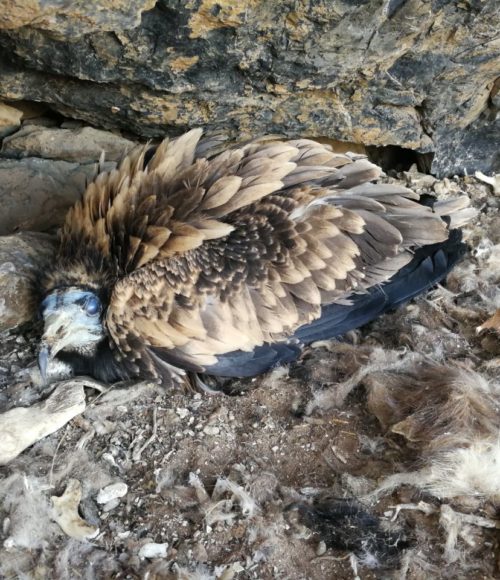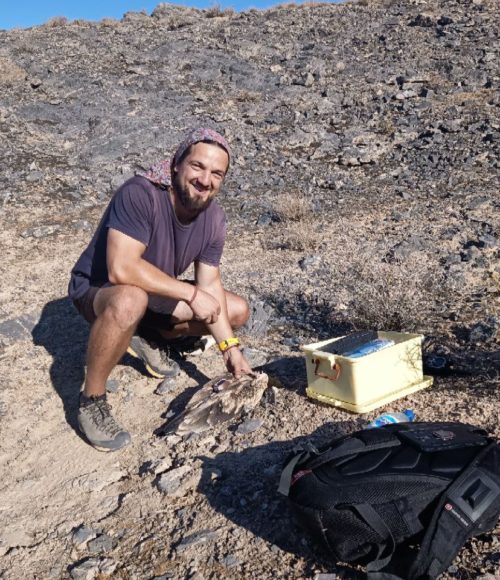
Migration is one of the most dangerous times for birds, and populations of many migratory species are in rapid decline. This is also the case for the Egyptian Vulture, the only true migrant among the Old World vultures, and an Endangered species. There are two distinct populations of Egyptian Vulture, one across Africa, the Middle East and Europe and the other in central and south Asia. A big challenge with conserving migratory species is that birds often encounter different threats in the different areas they spend their time. This can be in the breeding grounds, along their migration routes, or where they spend the winter. The variation in the threats Egyptian Vultures face is well studied for the population in Europe, Middle East and Africa, but very little is known about the threats to Egyptian Vultures that migrate in central Asia.
This project aims to address this critical gap in knowledge, so we can understand the threats they face and how to effectively implement conservation actions for this Endangered species.
Our Head of Conservation, Research and Education, Dr Campbell Murn, talks about our Egyptian Vulture Migration Project.
This exciting project is tracking Egyptian Vulture movements in central Asia for the first time and we are delighted to be involved. This invaluable research will help us to understand more about this Endangered species and how we can ensure its survival in central Asia. We are involved by helping to fund satellite tags to fit to some of the vultures, working on the analyses and publications that will highlight the results, and by sharing updates and news on the project.
The research started in Uzbekistan, which is the perfect location to focus on Egyptian Vultures in the central Asian population because there is a known breeding population there. Uzbekistan is also the only country in central Asia with a recently updated National Action Plan for Egyptian Vultures. Finally, Uzbekistan is at the crossroads of two major migration flyways used by many bird species, so research on migration routes and major threats along those routes is beneficial for a number of birds of prey and other species using the flyways. Fieldwork and project networking with colleagues has since expanded to other central Asian countries including Kazakhstan and Tajikistan.
The fieldwork takes place in several locations, including in the Kyzylkum desert of Uzbekistan, where the field team have identified nesting areas of Egyptian Vultures and the young birds we aim to tag. Juvenile birds are fitted with GPS satellite tags just before they fledge from their nest, so their movements as they migrate can be tracked. The tags use cutting-edge satellite telemetry technology to track the birds’ movements, giving us multiple GPS points per day, and will last for more than three years. This will provide us with a wealth of extremely valuable data and information about the timings and routes of their migrations.
The project will run for several years, with plans to tag multiple birds each year, to gather as much data about their movements as possible.
The project started in August 2021, where the team successfully tagged three juvenile birds. The field team have also found several congregation sites where adults feed around dumpsites as well as new breeding territories in southern Uzbekistan, a vital find for their future conservation. These sites were used to help the team tag five more individuals in 2022 including the first adult, and four more adults in both the third and fourth years with 16 birds in total now tagged in Uzbekistan so far. Tagging more adult birds will hopefully give us some useful insights into routes the more experienced birds take during migration. These congregation sites have also enabled the field team to start gathering more robust data on population numbers of the vultures in central Asia.


Each of the first juvenile birds that were tagged took very different routes after leaving their nests, with some surprising results! Two of the birds, Arys and Anya, took relatively similar routes, through Turkmenistan, Afghanistan and Pakistan, with both ultimately concluding their inaugural journeys to winter in northern India. Timur, however, took a very different route, with an incredible 6200km journey in total. After leaving Uzbekistan and passing through Turkmenistan, he made a much longer journey further to the west with several stops, pausing in Iran, then continuing around the Persian Gulf through Iraq, Kuwait, Saudi Arabia, eventually reaching Yemen in late November 2021. Sadly, Timur’s tag showed he stopped moving in 2023, in Yemen, where he is suspected to have died by poisoning. Data from Europe shows that rarely do more than half the young Egyptian Vultures make it to adulthood. Including Timur, three Egyptian Vultures tagged in Uzbekistan as part of this project have died, reaffirming the dangers these birds face. The data from all these birds provide a huge contribution to our understanding of where they are going, the threats they face and how to effectively implement conservation actions to help them.
So far, we have learnt that the picture is much more complex than we anticipated. This ground-breaking research is absolutely vital for the future conservation of the species.
The project is run by Dr Robert (John) Burnside (University of East Anglia), Dr Vladimir Dobrev (Bulgarian Society for Protection of Birds), Anna Ten and Valentin Soldatov (Institute of Zoology, Uzbekistan).
Our support will help to fund satellite tags for the birds, along with Oriental Bird Club and the Ornithological Society of the Middle East.